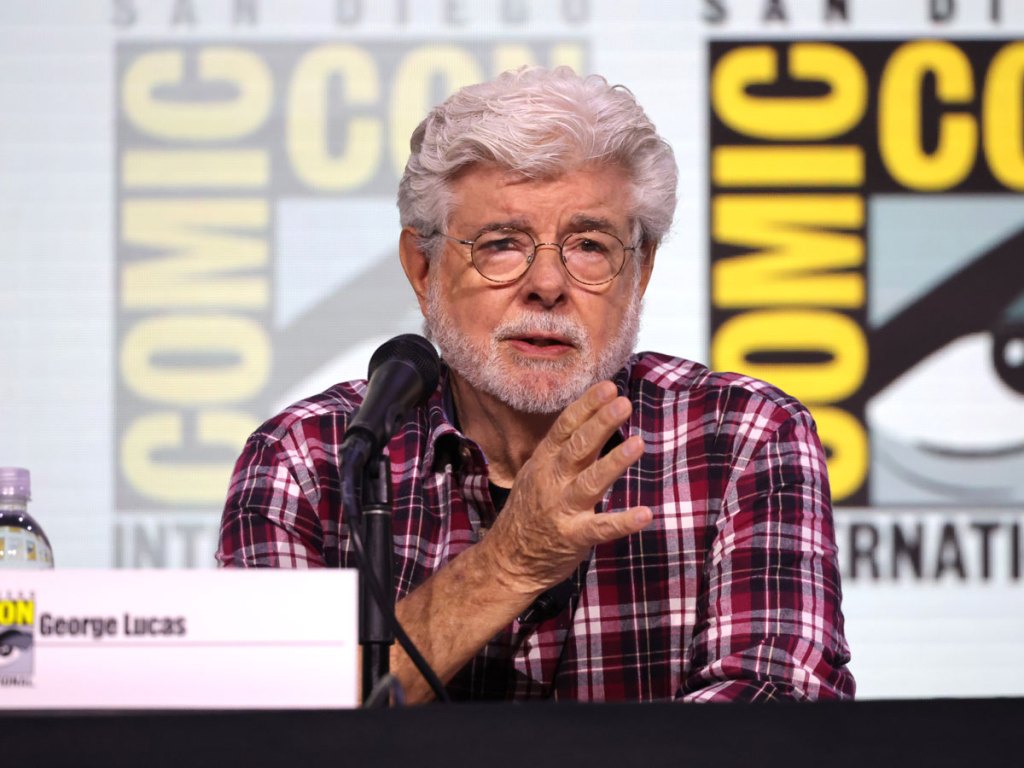History was made at Comic-Con’s famed Hall H on Sunday as George Lucas made his long-awaited Comic-Con debut. Lucas wasn’t there to discuss his acclaimed Star Wars trilogies, the Indiana Jones franchise, the cult classic, American Graffiti, or any of his other cinematic projects. Instead, he was there to reveal new details for his equally long-awaited Lucas Museum of Narrative Art, which is set to open in Los Angeles next year.
In front of a roaring audience of 6,500, the panel, titled “Sneak Peek of the Lucas Museum of Narrative Art, also included Academy Award–winning director Guillermo del Toro, who also serves on the museum’s board, and production designer Doug Chiang, who has collaborated on numerous film projects with Lucas. Queen Latifah served as moderator. The panel was Lucas’s first public appearance related to the museum since Sandra Jackson-Dumont stepped down as director and CEO in February and since a round of staff layoffs in May.
Related Articles

Cofounded by Lucas and his wife, Mellody Hobson, the Lucas Museum describes narrative art as being “created to represent stories through images,” with the aim to show “how narrative art influences societies—shaping beliefs, communicating values, inspiring imagination, and creating communities,” according to its website. The couple have appeared on ARTnews’s Top 200 Collectors list since 2020.
Visitors’ first interaction with narrative art will be museum’s building, a 300,000-foot-structure, designed by architect Ma Yansong of MAD. “The shape of the museum for me—what it is, is flow,” del Toro said during the panel. “And what is beautiful is that we are [collectors]. George is a collector. I’m a collector, but I know I don’t own anything. I’m holding [the artworks] briefly for the next person that is going to hold it or see it.”

Rendering of the building for the forthcoming Lucas Museum of Narrative Art in Los Angeles.
Courtesy Lucas Museum of Narrative Art.
Sited in Exposition Park, the museum’s campus will also include 11 acres of green space, with a landscape design by Mia Lehrer, of Studio-MLA. Inside will be 33 galleries, two theaters, a retail space, a restaurant, a cafe, a library, and an event venue, according to a video narrated by Samuel L. Jackson.
Lucas’s enthusiasm for narrative art dates back more than five decades, when he started collecting in college. The museum’s founding collection consists of more than 40,000 works that Lucas has amassed. The works in his personal collection are by artists who “have created images that give our society a shared set of beliefs. Shared beliefs create community,” he said. “The idea is that I couldn’t really afford real art. I love all art, no matter what it is. But I could afford comic art, because in those days it was underground.”
He described himself as “not a typical art collector who buys [something], and then comes back five years later and says ‘I sold it for $10,000.’ I could never do that. It’s not what I think art is. I think it’s more about a connection, an emotional connection with the work, not how much it cost or what celebrity did it or whatever. It’s more of a personal thing.”
Lucas, a longtime collector of Norman Rockwell, pointed to the artist’s iconic 1943 painting Freedom from Want, of a family sitting down for a holiday meal with a turkey, to explain how he views narrative art and its connection to community, emotion and the development of societal beliefs. “[The] painting tells you that family is important,” Lucas said. “It’s part of what we need to keep society together even if it’s tough…that’s a lot of [what] the art centers around, those ideas of what we believe in and how important that is to us to have a community and to be able to build off of a common belief. Society cannot exist without a common belief system and that’s where illustration is vital to show you what that means in everyday life.”

Frida Kahlo, Autorretrato dedicado al Dr. Eloesser (Self-Portrait Dedicated to Dr. Eloesser), 1940.
Photo: Randy Dodson/Courtesy Fine Arts Museums of San Francisco; Art: ©2021 Banco de México Diego Rivera Frida Kahlo Museums Trust, Mexico, D.F. / Artists Rights Society (ARS), New York/Lucas Museum of Narrative Art, Los Angeles
In addition to featuring works by artists such as Kadir Nelson, Beatrix Potter, Frida Kahlo—alongside models, props, concept art, and costumes from Lucas’s filmmaking career—Queen Latifah revealed the museum will also house “the very first character drawing of Flash Gordon from 1934, original sketches from the Peanuts comics from the ’50s and ’60s, original drawings from Iron Man’s first cover in 1968, and an original pen and ink splash of Black Panther.”
Chiang commended Lucas for the museum’s inclusivity of various art forms, especially genres that have historically been looked down upon within museum contexts, like comics books, which were how he first “fell in love with art.” He added, “What I love about what George and Melody are doing in creating this museum is that it’s celebrating and acknowledging and giving respect to an art form that has really hasn’t been highlighted before.”
Lucas concluded, “This museum is dedicated to the idea that stories, mythology, any kind of story that is written to affect people and to build community is extremely important to society and creating societies and creating community. Art illustrates that story, so this is sort of a temple to the people’s art.”

